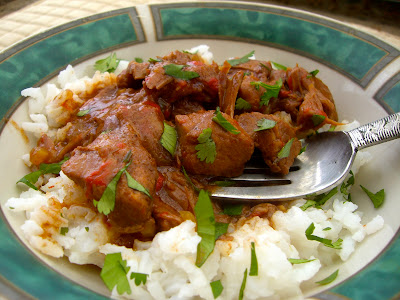 |
| Photo by Valerie Phillips |
Protein — meat, poultry, seafood, etc. — can be one of the highest-priced food categories at the supermarket. Here are ten ways to stretch your dollars:
1. Compare prices on chicken parts. Unless they're on special, breasts are the most expensive part of the chicken. Boneless, skinless thighs offer the same convenience, usually for less money, and dark meat is more moist and flavorful anyway.
2. Take a cue from restaurant chefs who can make a small portion of meat or chicken look plentiful. They slice it thinly and fan out the slices on top of a mound of rice or potatoes.
3. Tough cuts of meat are usually cheaper. Place a beef stewing meat or brisket in you slow cooker in the morning, with a little liquid and seasonings. By dinner time you'll have tender beef (and a tantalizing aroma in your kitchen).
4. Don't throw out your bacon drippings. They can add flavor to casseroles or rice dishes. Interesting suggestions from Every Day With Rachael Ray magazine: Stir drippings into grits, saute bread cubes for croutons, add to cornbread batter, or add to barbecue sauce and brush on ribs or chicken while they're cooking.
5. Compare meat costs by servings, not pounds. Bony meats are cheaper per pound, but you don’t get as many servings from it.
6. Sometimes convenience is worth it. A large store-cooked rotisserie chicken at $6 is actually cheaper than buying a raw, 5-pound whole raw chicken at $1.30 per pound and cooking it at home. And, you’re saving oven time. Either way, use the carcass and bits of leftover meat to make chicken broth.
7. Although the price of eggs more than doubled in the past year, a $2-$3 carton of eggs can still supply a protein-rich meal for a family. Scramble them with leftovers such as chopped ham, crumbled bacon, chopped peppers, onions and so on.
8. Buy ground beef, pork chops, etc. in bulk quantities to get a better price. When you get home, divide meal-size portions in zip-lock bags and freeze.
9. If you're preparing a commercial meal kit (such as Hamburger Helper or a frozen pasta dinner), toss in a few more vegetables. Chopped bell peppers or celery, and frozen broccoli or peas add color, flavor and nutrition to what is usually a lot of starch, sauce and salt. They can also stretch the meal into more servings.
10. Beans are an inexpensive protein. Add them to tacos, casseroles, salads, etc., so you can use less meat. Dried beans, per cooked serving, are often less than half the price of canned beans. Soak a batch overnight in your slow cooker on low heat, then portion and freeze for later use.
11. Some people advise using cheese as a protein instead of meat to save money. But when cheese can easily cost $4 per pound, it' doesn't seem like much of a cost savings.
12. They're not leftovers, they're planned-overs. A serving of grilled chicken can be chopped into tomorrow's soup. A few slices of ham can be turned into ham fried rice. Or leftovers can become tomorrow's lunch. But it won't happen if you stow your leftovers in the fridge and forget about them for a week.
No comments:
Post a Comment